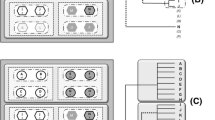Abstract
Taxon identification is one of the fundamental challenges in biological research. Usually, classifications are based on specimen morphology, sometimes supported by their behaviour, ecology or biochemistry. Technological advances now allow using genomic fragments as a taxon barcode. With the latest developments of high-throughput sequencers this can go even further: identifying complete assemblages simultaneously, with various applications in ecology, conservation, forensics and health security.
Similar content being viewed by others
Literatur
Woese CR, Fox GE (1977) Phylogenetic structure of the prokaryotic domain: the primary kingdoms. Proc Natl Acad Sci USA 74:5088–5090
Fox GE, Pechman KR, Woese CR (1977) Comparative cataloging of 16S ribosomal ribonucleic acid: molecular approach to procaryotic systematics. Int J Syst Evol Microbiol 27:44–57
Hebert PD, Cywinska A, Ball SL et al. (2003) Biological identifications through DNA barcodes. Proc Biol Sci 270:313–321
Dupuis J, Row A, Sperling F (2012) Multi-locus species delimitation in closely related animals and fungi: one marker is not enough. Mol Ecol 21:4422–4436
Keller A, Danner N, Grimmer G et al. (2015) Evaluating multiplexed next-generation sequencing as a method in palynology for mixed pollen samples. Plant Biol 17:558–566
Junker RR, Keller A (2015) Microhabitat heterogeneity across leaves and flower organs promotes bacterial diversity. FEMS Microbiol Ecol 91:fiv097 (doi: 10.1093/femsec/fiv097)
Bálint M, Schmidt P, Sharma R et al. (2014) An Illumina metabarcoding pipeline for fungi. Ecol Evol 4:2642–2653
Sickel W, Ankenbrand M, Grimmer G et al. (2015) Increased efficiency in identifying mixed pollen samples by meta-barcoding with a dual-indexing approach. BMC Ecol 15:20
Yu D, Ji Y, Emerson B et al. (2012) Biodiversity soup: metabarcoding of arthropods for rapid biodiversity assessment and biomonitoring. Methods Ecol Evol 3:613–623
Nilsson R, Ryberg M, Kristiansson E et al. (2006) Taxonomic reliability of DNA sequences in public sequence databases: a fungal perspective. PLoS One 1:e59
Bell K, de Vere N, Keller A et al. (2016) Pollen DNA barcoding: current applications and future prospects. Genome (im Druck)
Author information
Authors and Affiliations
Corresponding author
Additional information
Alexander Keller, Gudrun Grimmer, Wiebke Sickel und Markus J. Ankenbrand (v. l. n. r.)
Die Molecular Biodiversity Group der Universität Würzburg ist eine Nachwuchsforscher-AG, die sich mit ökologischen Artgemeinschaften beschäftigt. Wir analysieren Wirt-Mikroben-Inter - aktionen von Pflanzen und Insekten sowie Pflanzen- Bestäuber-Interaktionen. Zudem sind wir in der Methodenentwicklung für Metabarcoding aktiv.
Rights and permissions
About this article
Cite this article
Keller, A., Grimmer, G., Sickel, W. et al. DNA-Metabarcoding – ein neuer Blick auf organismische Diversität. Biospektrum 22, 147–150 (2016). https://doi.org/10.1007/s12268-016-0669-0
Published:
Issue Date:
DOI: https://doi.org/10.1007/s12268-016-0669-0




